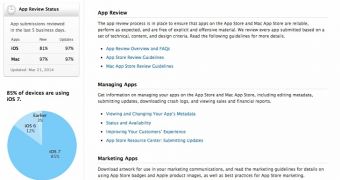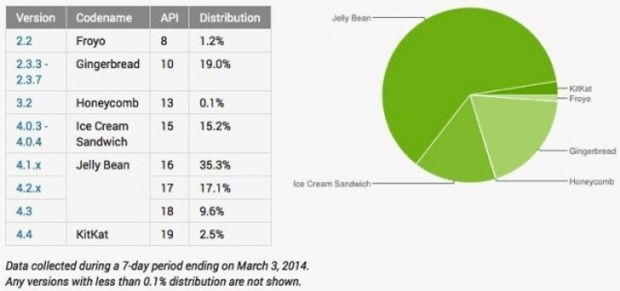As measured by the App Store team during a seven‑day period ending March 23, 2014, 85 percent of iDevices are now using iOS 7 (which includes iOS 7.1). The figure makes for a stark comparison with Google’s Android ecosystem.
Dug up by CultofMac, the updated numbers placed next to the situation over in Google’s camp reveal a huge contrast. iOS 7, the latest major version of Apple’s mobile operating system, is now installed on 85% on iPhones, iPads, and iPod touch devices worldwide.
This includes iOS 7.0.1 through 7.0.6 and iOS 7.1, though Apple doesn’t say exactly how many people are on the absolute newest firmware version. According to a count made by Chitika earlier this month, 24 hours after the launch of iOS 7.1, six percent of all iDevices out there were up and running with the new firmware.
Looking at the Android install base, things are different. Very different. Countless versions scattered all over the place, ranging from the age-old 2.2 Froyo to the new 4.4 KitKat, which hardly sits on 2.5% of all Droids out there. By comparison, the same amount of people in the iOS sphere are on the oldest available firmware (3.x, 4.x, 5.x).
Most people in the Android camp are using a flavor of 4.1.x JellyBean, which can be compared to iOS 6 in the Apple customer base. However, iOS 6 is only on 12 percent of all iDevices used today.Apple has several aces up its sleeve, including over-the-air (OTA) updates and better marketing. People tend to respond better to single-digit numbering schemes rather than references to sweets. Apple also does a stellar job at explaining every new feature and what it does to enhance their iPhone / iPad / iPod and their experience.
The sporadic Android adoption is mostly attributed to user confusion, whereas in the Apple base more people seem to make the connection between certain device types and certain firmware – for example, which devices can take iOS 7 and which can’t.
Although Google likes to brag that its market share has surpassed that of Apple, iOS loyalists spend more time using their devices for online transactions, generating ad impressions, etc. At the end of the day, market share only counts when your customers are actually using the product.
This, in turn, generates an incentive for developers to create apps for that platform. Not surprisingly, the App Store holds over a million different apps, half of which are tailored specifically for iPads.

 14 DAY TRIAL //
14 DAY TRIAL // 

